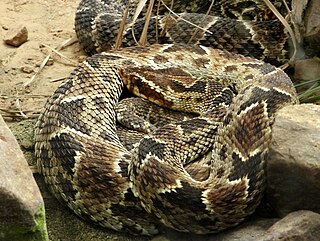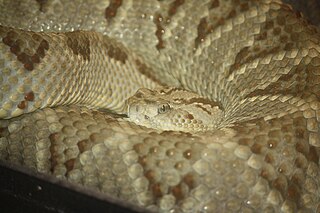
Bothrops atrox — also known as the common lancehead, fer-de-lance, barba amarilla and mapepire balsain — is a highly venomous pit viper species found in the tropical lowlands of northern South America east of the Andes, as well as the Caribbean island of Trinidad. No subspecies are currently recognized.

Bothrops is a genus of highly venomous pit vipers endemic to the Neotropics. The generic name, Bothrops, is derived from the Greek words βόθρος, bothros, meaning "pit", and ώπς, ops, meaning "eye" or "face", together an allusion to the heat-sensitive loreal pit organs. Members of this genus are responsible for more human deaths in the Americas than any other group of venomous snakes. Currently, 48 species are recognized.

Bothrops alternatus is a highly venomous pit viper species found in South America. Within its range, it is an important cause of snakebite. The specific name, alternatus, which is Latin for "alternating", is apparently a reference to the staggered markings along the body. No subspecies are currently recognized.

Terciopelo is a species of pit viper found at low to moderate elevations in northeast Mexico and Central America, and into South America where it is known from elevations up to 2600 meters in the Colombian and Ecuadorian Andes, as well as into Venezuela. With a mass of up to 6 kilograms (13 lb) and a maximal length of 2.5 metres (8.2 ft), the terciopelo is among the largest pit vipers. It is light to dark brown in color, often with yellow zig-zag-shaped lines on each side of the body. Dubbed "the ultimate pit-viper" for its large size, fangs and venom yield, it has a fearsome reputation, responsible for the most snakebites within its range because of its defensive temperament and proximity to human residence. However, like other venomous snakes, it avoids confrontation with humans whenever possible. No subspecies are currently recognized.

Atheris is a genus of vipers known as bush vipers. They are found only in tropical subsaharan Africa and many species have isolated and fragmented distributions due to their confinement to rain forests. Like all other vipers, they are venomous. In an example of convergent evolution, they show many similarities to the arboreal pit vipers of Asia and South America. Seventeen species are currently recognized.

Echis is a genus of vipers found in the dry regions of Africa, the Middle East, India, Sri Lanka and Pakistan. They have a characteristic threat display, rubbing sections of their body together to produce a "sizzling" warning sound. The name Echis is the Latin transliteration of the Greek word for "viper" (ἔχις). Like all vipers, they are venomous. Their common name is "saw-scaled vipers" and they include some of the species responsible for causing the most snakebite cases and deaths in the world. Twelve species are currently recognized.

Bothrops barnetti, also known commonly as Barnett's lancehead and Barnett's pit viper, is a species of venomous snake, a pit viper in the subfamily Crotalinae of the family Viperidae. The species is endemic to Peru. There are no subspecies that are recognized as being valid.

Bothrops ammodytoides is a venomous pit viper species endemic to Argentina. No subspecies are currently recognized.

Crotalus simus is a venomous pit viper species found in Mexico and Central America. The specific epithet is Latin for "flat-nosed", likely because its head is blunt compared with lanceheads (Bothrops). Three subspecies are recognized, including the nominate subspecies described here.

Bothrops jararaca — known as the jararaca or yarara — is a highly venomous pit viper species endemic to South America in southern Brazil, Paraguay, and northern Argentina. The specific name, jararaca, is derived from the Tupi words yarará and ca, which mean 'large snake'. Within its geographic range, it is often abundant and is an important cause of snakebite. No subspecies are currently recognized.

Bothrops taeniatus, the speckled forest-pitviper, is a species of pit viper found in the equatorial forests of South America endemic to Colombia, Ecuador, Peru, And Brazil. The specific name, taenia, is derived from the Greek word, tainia, meaning ribbon bandage or stripe, in reference to the slender body. Two subspecies are currently recognized, including the nominate subspecies described here.

Bothrops bilineatus, also known as the two-striped forest-pitviper, parrotsnake, Amazonian palm viper, or green jararaca, is a highly venomous pit viper species found in the Amazon region of South America. Two subspecies are currently recognized, including the nominate subspecies described here. A pale green arboreal species that may reach 1 m (3.3 ft) in length, it is an important cause of snakebite throughout the entire Amazon region.

Bothrops oligolepis is a venomous pitviper species found in Peru and Bolivia. The specific name is derived from the Greek words oligo and lepis, meaning "few scales"; probably an allusion to the lower numbers of dorsal and ventral scales that it has compared to B. bilineatus. No subspecies are currently recognized.
Bothrops pulcher is a venomous pitviper species found in South America. The specific name is Latin, meaning "beautiful", in reference to the color pattern. No subspecies are currently recognized.

Bothrops punctatus is a venomous pitviper species found in Ecuador, Mostly in the Chocó Department in Western Colombia and Panama. No subspecies are currently recognized.

Bothrops brazili is a venomous pitviper species endemic to South America. There are no subspecies that are recognized as being valid.

The lacunolabial scale is a large scale that forms in some crotaline snakes (pitvipers) when the prelacunal scale fuses with the second supralabial scale. In such cases, it is often said that "the second labial enters the pit". Some pitvipers, such as Bothrops alternatus, Bothrops erythromelas, Bothrops itapetiningae and Bothrops neuwiedi, have a divided lacunolabial scale.

Bothrops moojeni, commonly known in English as the Brazilian lancehead, is a species of venomous snake in the family Viperidae. It is a pit viper endemic to South America.

Bothrops venezuelensis, or the Venezuelan lancehead, is a species of venomous snake in the family Viperidae. It is endemic to South America.

Snakebite envenomation is considered a public health problem in Latin America, with an estimated 70,000 cases annually, but due to underreporting, these numbers may be even higher.



















